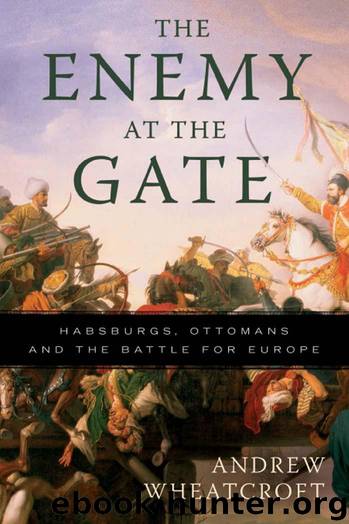The Enemy at the Gate by Wheatcroft Andrew

Author:Wheatcroft, Andrew. [Wheatcroft, Andrew.]
Language: eng
Format: mobi, epub
Published: 2009-03-05T19:46:29+00:00
046501374-text.qxd:Layout 1 2/17/09 11:08 AM Page 188
9
A Holy War?
When dawn broke on Monday 13 September 1683 the Turkish host
had already vanished. A few unfortunate miners stumbling up from the underground workings before the walls, oblivious of time and the transformation of events, were taken prisoner and quickly slaughtered. The Ottomans had left behind a ghost city of tents, a vast camp that was pillaged and re-pillaged. Overnight the Polish cavalry had taken the first cut, and then in the morning the Habsburg and im -
perial forces took what was left as their share. The Viennese swarmed out from the foetid city and snatched what remained. A half-truth was that they found bags of small beans – coffee – that were used to establish the first of Vienna’s coffee houses. Rumour had it that Georg Franz Kolschitzky, whose exploits carrying messages through the Turkish lines had made him a hero of the siege, knew what these nondescript goods were, and secured the right to establish the first coffee shop in the city. This was a fiction, put about by Kolschitzky, who wanted a new monopoly for his own coffee house. It now seems that an Armenian, Johannes Diodato, is a more likely candidate, but the men had something in common. Both spoke Ottoman Turkish,
both moved freely and easily between the cultures of West and East.
The coffee house legend illustrates a facet of Vienna obscured in the exultation of triumph. The city, like almost any frontier town, had commercial connections across the notional border, usually carried out by intermediaries.1 Many of those expelled from the city or killed at the beginning of the siege were ‘Turks’, outsiders from the lands 046501374-text.qxd:Layout 1 2/17/09 11:08 AM Page 189
A H O LY WA R ?
189
east of Royal Hungary, but Christians or Jews and not Muslims. Vienna had been the bastion of the West against the Ottoman East for centuries, but it was also a point of contact with the East. Certainly a long history of fear and hostility dominated popular attitudes. The old tale of Ottoman captivity written by Johannes Schiltberger was one of the most successful medieval texts to be printed in German, and was still widely read in the seventeenth century.2 Schiltberger told a graphic story of the crusade of Nicopolis, and the battle in which he had been captured. It was fought in September 1396 and afterwards the Ottoman sultan had watched as the defeated chivalry of Europe were decapitated one by one, in revenge for the Turks killed when the crusaders had taken Nicopolis. The story of Hans, lord of Greif, made him a hero for future generations.
I saw the lord Greif, who was a noble of [Bavaria], and four others, bound with the same cord. When he saw the great revenge that was taking place, he cried with a loud voice and consoled the horsemen and foot soldiers who were standing there to die. ‘Stand firm,’ he said.
‘When our blood this day is spilt for the Christian faith, we by God’s help shall become the children of heaven.
Download
This site does not store any files on its server. We only index and link to content provided by other sites. Please contact the content providers to delete copyright contents if any and email us, we'll remove relevant links or contents immediately.
| Africa | Americas |
| Arctic & Antarctica | Asia |
| Australia & Oceania | Europe |
| Middle East | Russia |
| United States | World |
| Ancient Civilizations | Military |
| Historical Study & Educational Resources |
Empire of the Sikhs by Patwant Singh(22769)
The Wind in My Hair by Masih Alinejad(4847)
The Templars by Dan Jones(4561)
Rise and Kill First by Ronen Bergman(4547)
The Rape of Nanking by Iris Chang(4024)
12 Strong by Doug Stanton(3420)
Blood and Sand by Alex Von Tunzelmann(3060)
The History of Jihad: From Muhammad to ISIS by Spencer Robert(2507)
Babylon's Ark by Lawrence Anthony(2433)
The Turkish Psychedelic Explosion by Daniel Spicer(2246)
No Room for Small Dreams by Shimon Peres(2239)
Gideon's Spies: The Secret History of the Mossad by Gordon Thomas(2237)
Inside the Middle East by Avi Melamed(2233)
Arabs by Eugene Rogan(2196)
The First Muslim The Story of Muhammad by Lesley Hazleton(2157)
Bus on Jaffa Road by Mike Kelly(2036)
Come, Tell Me How You Live by Mallowan Agatha Christie(2030)
Kabul 1841-42: Battle Story by Edmund Yorke(1926)
1453 by Roger Crowley(1881)
